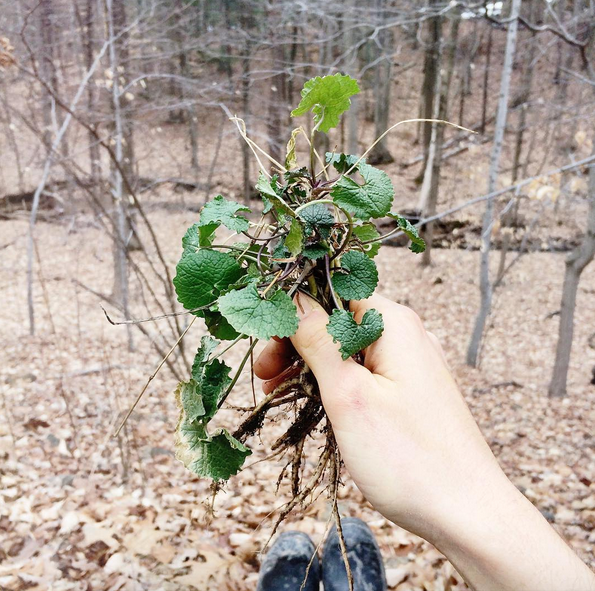The past two weeks have been a whirlwind (honestly, how many blog posts start with that freakin' statement), but really, they have. My stress levels have been 6,000 and for some reason I figured that would be a good time to switch up what herbs I start my day with (i.e, Passionflower, I am sorry I doubted your ability to quell obsessive, circular thinking. I will start taking you again STAT!). On top of that, I am planning on moving out (!!), buying a car (!!!) and the weather has been back and forth (such is Spring, the energy of Wind, don't you know).
Through all of that, all the stress and feelings of "what am I doing I can't do this why am I doing this and not that," it is the Plant kingdom that grounds me. When I am walking in the woods, I am home.
Home among the ramp leaves that I have infused into ACV, home among the Blue Cohosh's that look like little demonic claws coming out of the ground and home among the Cardinals who repeatedly fly into my window to tell me to cut that SHIT out, Blaire, you know better (this time, I listened), and home among the River that reminds me to let it go let it go leeeeeet it goooo.
Anyway - Beltane marks the midpoint of Spring, the halfway point between Spring and Summer, to me, marks the beginning of what Summer represents: complete and total immersion in the plants and all the joy, ecstasy and purpose that they can bring into our lives and have brought into mine. And while I spent this Beltane doing my Triune homework, being sick as a dog and eating turmeric/cumin guacamole and a bar of 90% chocolate, I did get to get outside yesterday. So, alas, please enjoy what I have found, this week, in plants:
Trillium / Blue Cohosh / Wild Geranium / Soloman's Seal / Cosmic Fern Babies
TRILLIUM
I don't know much about Trilliums, just that they are on the UPS list, and that they are a rare sight in New Jersey, so it was a joy (understatement) to come across a blooming Trillium this weekend.
Accordingly to Woodland Essences, Trillium essence helps one feel as if they are "coming home to oneself," which is exactly the feeling I got when I saw this beauty blooming on my way out of the forest. A gentle reminder of the healing that takes place in nature, the simple joy of seeing a wild flower bloom and the cyclic nature of time and that things are going to bloom, and die, and they will continue to do that even when we are gone, but that if we stop to watch and appreciate that cycle, the endless anxiety of the modern world does seem to stop, if only for a moment.
WILD GERANIUM (Geranium maculatum)
A somewhat shy plant, at least to me, Wild Geranium is primarily used in Western Herbalism as an astringent/stypic. Rich in tannins (10-28%), this plant can be used for weeping wounds, diarrhea and ulcers, both gastric and in the mouth (as a gargle). As with any tannin-rich plant, avoid taking it with iron supplements and alkaloid containing medications, and limit your consumption to acute issues, as they can cause constipation.
.....are you KIDDING me... with this plant... the beauty...
SOLOMAN'S SEAL (Polygonatum biflorum)
I can't even believe this plant is real. Between how majestically it unfolds as it flowers, and how clear its Doctrine of Signature's is, this plant is something else. This moist woodland dweller is what in TCM would be called a "yin tonic," and it is specific for joints and cartilage that need nourishment (hence the flowers at various knobs, ya dig). The root can also be used in other situations of dryness: dry cough, dry constipation and dry mucous that is difficult to cough out (as I type this I realize how badly I currently need it). According to David Winston, the leaves were often eaten by the Cherokee and referred to as sweet salad, or "Uganosti".
As with any root, harvest wisely and consciously. Herbalist jim mcdonald has a great post on harvesting this native plant in a respect way that doesn't damage the ecosystem. It's also much more in depth should you feel called to learn more about this plant!
BLUE COHOSH (Caulophyllum thalictroides)
Otherwise known as death claw lookin' plant, at least to me, this plant is primarily used as an antispasmodic to the reproductive system (ovaries, uterus, testicles) and an anti-inflammatory to arthritic joints, especially fingers and toes. The root has traditionally been used as an oxytocic to stimulate labor, but as I have 0 midwife training, this isn't something I can or would recommend.
This plant is on the "at risk" list of United Plant Saver's, so if you feel the need to use it medicinally, do so by purchasing it from a reputable source - not wildcrafting.
Anyone got an iD on this cosmic fella?
As I wrap up this blog post, I am overcome with feelings of inadequacy. That I haven't written enough about these plants, or provided a materia medica for each one- but, that's not the point of this series (and that also means I need to continue taking my Larch flower essence and get back on my Passiflora/Rosa tincture regiment).
The point of this series is for me to learn the Latin names of the plants around me, to take notice of what is blooming and when, and to become more acquainted with the land that I walk on and that nourishes me in more way than one. I hope it inspires you at look down when you are walking, whether that be in Brooklyn or in Vernon, NJ, and to take note of what plants are unfurling their inflorescence and petals. Notice the bugs pollinating the flowers as you go to pick them, and let them inspire you to always take less than what you think you need - because we aren't the only ones who depend on these plants - entire ecosystems depend on these plants.
“To love a place is not enough.
We must find ways to heal it.”
- Robin Wall Kimmer
(what that quote means is always bring a trash bag into the woods so you can pick up after our fellow humans that for some godforsaken reason leave cigarette butts and health food wrappers ?!?!! in the woods) (it also means systemic change so the earth can live)
Until next time (which will be after I get back from HAWAII and oh boy oh boy the plants I will have to share!!),
B























